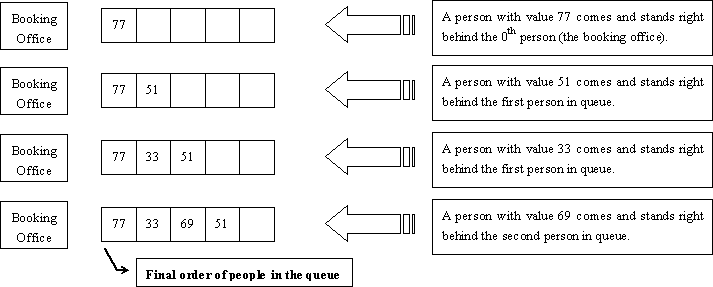poj-----(2828)Buy Tickets(线段树单点更新)
| Time Limit: 4000MS | Memory Limit: 65536K | |
| Total Submissions: 12930 | Accepted: 6412 |
Description
Railway tickets were difficult to buy around the Lunar New Year in China, so we must get up early and join a long queue…
The Lunar New Year was approaching, but unluckily the Little Cat still had schedules going here and there. Now, he had to travel by train to Mianyang, Sichuan Province for the winter camp selection of the national team of Olympiad in Informatics.
It was one o’clock a.m. and dark outside. Chill wind from the northwest did not scare off the people in the queue. The cold night gave the Little Cat a shiver. Why not find a problem to think about? That was none the less better than freezing to death!
People kept jumping the queue. Since it was too dark around, such moves would not be discovered even by the people adjacent to the queue-jumpers. “If every person in the queue is assigned an integral value and all the information about those who have jumped the queue and where they stand after queue-jumping is given, can I find out the final order of people in the queue?” Thought the Little Cat.
Input
There will be several test cases in the input. Each test case consists of N + 1 lines where N (1 ≤ N ≤ 200,000) is given in the first line of the test case. The next N lines contain the pairs of values Posi and Vali in the increasing order of i (1 ≤ i ≤ N). For each i, the ranges and meanings of Posi and Vali are as follows:
- Posi ∈ [0, i − 1] — The i-th person came to the queue and stood right behind the Posi-th person in the queue. The booking office was considered the 0th person and the person at the front of the queue was considered the first person in the queue.
- Vali ∈ [0, 32767] — The i-th person was assigned the value Vali.
There no blank lines between test cases. Proceed to the end of input.
Output
For each test cases, output a single line of space-separated integers which are the values of people in the order they stand in the queue.
Sample Input
4
0 77
1 51
1 33
2 69
4
0 20523
1 19243
1 3890
0 31492
Sample Output
77 33 69 51
31492 20523 3890 19243
Hint
The figure below shows how the Little Cat found out the final order of people in the queue described in the first test case of the sample input.

Source
#include<cstdio>
#include<cstring>
const int maxn=;
struct node
{
int lef,rig,ps; //ps-->在前方有多少个空位
int val;
int mid(){
return lef+((rig-lef)>>);
}
};
struct sac
{
int pos,val;
};
sac sav[maxn];
node reg[maxn<<];
int ans[maxn];
int cnt;
void Build(int left,int right,int pos)
{
reg[pos]=(node){left,right,,};
if(left==right) return ;
int mid=reg[pos].mid();
Build(left,mid,pos<<);
Build(mid+,right,pos<<|);
reg[pos].ps=reg[pos<<].ps+reg[pos<<|].ps;
} void Update(int ps,int val ,int pos)
{
if(reg[pos].lef==reg[pos].rig)
{
reg[pos].ps=;
reg[pos].val=val;
return ;
}
int mid=reg[pos].mid();
if(reg[pos<<].ps>ps)
Update(ps,val,pos<<);
else Update(ps-reg[pos<<].ps,val,pos<<|);
reg[pos].ps=reg[pos<<].ps+reg[pos<<|].ps;
return ;
}
void Query(int pos)
{
if(reg[pos].lef==reg[pos].rig)
{
if(cnt==)
printf("%d",reg[pos].val);
else printf(" %d",reg[pos].val);
cnt++;
return ;
}
int mid=reg[pos].mid();
Query(pos<<);
Query(pos<<|);
return ;
}
int main()
{
int n;
while(scanf("%d",&n)!=EOF)
{
cnt=;
Build(,n,);
for(int i=;i<n;i++)
scanf("%d%d",&sav[i].pos,&sav[i].val);
for(int i=n-;i>=;i--)
Update(sav[i].pos,sav[i].val,);
Query();
puts("");
}
return ;
}
优化代码:
#include<cstdio>
#include<cstring>
const int maxn=;
struct node
{
int lef,rig,ps; //ps-->在前方有多少个空位
int mid(){
return lef+((rig-lef)>>);
}
};
struct sac
{
int pos,val;
};
sac sav[maxn];
node reg[maxn<<];
int ans[maxn];
void Build(int left,int right,int pos)
{
reg[pos]=(node){left,right,};
if(left==right) return ;
int mid=reg[pos].mid();
Build(left,mid,pos<<);
Build(mid+,right,pos<<|);
reg[pos].ps=reg[pos<<].ps+reg[pos<<|].ps;
} void Update(int ps,int val ,int pos)
{
if(reg[pos].lef==reg[pos].rig)
{
reg[pos].ps=;
ans[reg[pos].lef]=val;
return ;
}
int mid=reg[pos].mid();
if(reg[pos<<].ps>ps)
Update(ps,val,pos<<);
else Update(ps-reg[pos<<].ps,val,pos<<|);
reg[pos].ps=reg[pos<<].ps+reg[pos<<|].ps;
return ;
}
int main()
{
int n;
while(scanf("%d",&n)!=EOF)
{
Build(,n,);
for(int i=;i<n;i++)
scanf("%d%d",&sav[i].pos,&sav[i].val);
for(int i=n-;i>=;i--)
Update(sav[i].pos,sav[i].val,);
printf("%d",ans[]);
for(int i=;i<=n;i++)
printf(" %d",ans[i]);
puts("");
}
return ;
}
poj-----(2828)Buy Tickets(线段树单点更新)的更多相关文章
- POJ 2828 Buy Tickets(线段树单点)
https://vjudge.net/problem/POJ-2828 题目意思:有n个数,进行n次操作,每次操作有两个数pos, ans.pos的意思是把ans放到第pos 位置的后面,pos后面的 ...
- POJ - 2828 Buy Tickets (段树单点更新)
Description Railway tickets were difficult to buy around the Lunar New Year in China, so we must get ...
- poj 2828 Buy Tickets (线段树(排队插入后输出序列))
http://poj.org/problem?id=2828 Buy Tickets Time Limit: 4000MS Memory Limit: 65536K Total Submissio ...
- POJ 2828 Buy Tickets (线段树 or 树状数组+二分)
题目链接:http://poj.org/problem?id=2828 题意就是给你n个人,然后每个人按顺序插队,问你最终的顺序是怎么样的. 反过来做就很容易了,从最后一个人开始推,最后一个人位置很容 ...
- POJ 2828 Buy Tickets 线段树 倒序插入 节点空位预留(思路巧妙)
Buy Tickets Time Limit: 4000MS Memory Limit: 65536K Total Submissions: 19725 Accepted: 9756 Desc ...
- POJ 2828 Buy Tickets(线段树·插队)
题意 n个人排队 每一个人都有个属性值 依次输入n个pos[i] val[i] 表示第i个人直接插到当前第pos[i]个人后面 他的属性值为val[i] 要求最后依次输出队中各个人的属性 ...
- POJ 2828 Buy Tickets | 线段树的喵用
题意: 给你n次插队操作,每次两个数,pos,w,意为在pos后插入一个权值为w的数; 最后输出1~n的权值 题解: 首先可以发现,最后一次插入的位置是准确的位置 所以这个就变成了若干个子问题, 所以 ...
- poj 2828 Buy Tickets (线段树)
题目:http://poj.org/problem?id=2828 题意:有n个人插队,给定插队的先后顺序和插在哪个位置还有每个人的val,求插队结束后队伍各位置的val. 线段树里比较简单的题目了, ...
- poj 2892---Tunnel Warfare(线段树单点更新、区间合并)
题目链接 Description During the War of Resistance Against Japan, tunnel warfare was carried out extensiv ...
随机推荐
- Trigger Execution Sequence Of Oracle Forms
Sequence of triggers fires on Commit.1. KEY Commit2. Pre Commit3. Pre/On/Post Delete4. Pre/On/Po ...
- Change Or Set Report Object Property At Run Time In Oracle Forms Using Set_Report_Object_Property Command
Sets the Report object property at run time in Oracle Forms of an report object. The following are t ...
- Create Stacked Canvas to Scroll Horizontal Tabular Data Blocks In Oracle Forms
In this tutorial you will learn to create horizontal scrollable tabular or detail data block by usin ...
- SAP传输系统TMS、开发类、传输请求
声明:原创作品,转载时请注明文章来自SAP师太技术博客( 博/客/园www.cnblogs.com):www.cnblogs.com/jiangzhengjun,并以超链接形式标明文章原始出处,否则将 ...
- JS实现 键盘操作
JS实现 键盘操作: 详情可以去其逛网查看其API并下载,地址:http://craig.is/killing/mice <!DOCTYPE html PUBLIC "-//W3C// ...
- MVC 3 数据验证 Model Validation 详解
在MVC 3中 数据验证,已经应用的非常普遍,我们在web form时代需要在View端通过js来验证每个需要验证的控件值,并且这种验证的可用性很低.但是来到了MVC 新时代,我们可以通过MVC提供的 ...
- shell script创建库
先创建名称为 myfuns # my script functions function addem { + $ ] } function multem { * $ ] } function dive ...
- iOS - Swift NSEnumerator 迭代器
前言 public class NSEnumerator : NSObject, NSFastEnumeration 1.迭代器 let arr:NSArray = ["bei", ...
- iOS - Notification 通知
1.Notification 通知中心实际上是在程序内部提供了消息广播的一种机制,它允许我们在低程度耦合的情况下,满足控制器与一个任意的对象进行通信的目的.每一个 iOS 程序(即每一个进程)都有一个 ...
- Spring JDBC主从数据库配置
通过昨天学习的自定义配置注释的知识,探索了解一下web主从数据库的配置: 背景:主从数据库:主要是数据上的读写分离: 数据库的读写分离的好处? 1. 将读操作和写操作分离到不同的数据库上,避免主服务器 ...
